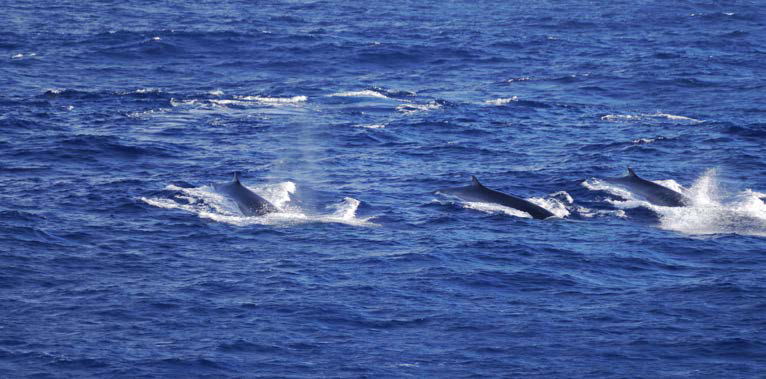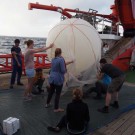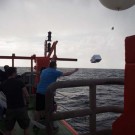The ’40-hr station’ (altered now to 48 hours) is well underway, with students participating in both day and night shifts. Although there are no lectures, there is still much work to do and a lot of coffee to drink. The night brought with it an increase in the swell of the waves, hence the ship is now rocking along 5 metre high waves. The amount of weather related complaints have increased slightly too as we all hope for higher temperatures. At least there has been no rain.
CTD’s have and will be deployed every six hours so there is plenty of sampling to do. Today we also reached a new milestone on the cruise, the release of a huge ozonesonde. Nearly a dozen helpers were on hand to assist with the operation. Thankfully, the wind wasn’t as extreme as it has been, so it was relatively easy to handle the large balloon. The data is now being downloaded as we type.
The ozonesonde launch was so successful that even a family of whales wanted to celebrate. Within minutes the ship started to lean to one side from the weight of all the people taking pictures. At one point a whale came within meters of the ship, forcing the crowd of whale spectators to gasp with excitement.
We are now around half way through the ’48-hour station’. Tomorrow, we will start heading towards Port Louis. In the meantime, the students will prepare and present the results they found during the last few days. It will be interesting to see everyones results.
by Steffen Fuhlbrügge & Michael Hemming



Great, but was ist CTD?
Good luck Gabriel
The CTD is the workhorse of oceanographic research. Its an acronym for Conductivity (used to calculate salinity), Temperature and Depth, the basic properties that describe seawater. But you can add other sensors as well like oxygen, chlorophyll, CO2…
What’s happening on board is that once in a while (depending on the resolution you need) a CTD cast is made. In German you would say:“eine CTD wird gefahren“. This means that the sensor package is lowered down to the bottom oft the ocean and up again, so you get the properties oft the whole water column. In addition there are 24 bottles attached to the CTD, which can be closed (we call it „firing a bottle“) at any depth. During this operation the ship has to stay at the same position. From these bottles, water samples are taken for further analysis.
Trivia: Our deepest CTD water sample was from 4500 meters. With a maximum rope speed of 1m/s it takes a long time to get to the bottom of things.
Alex